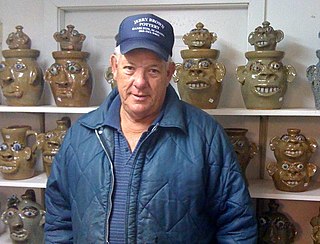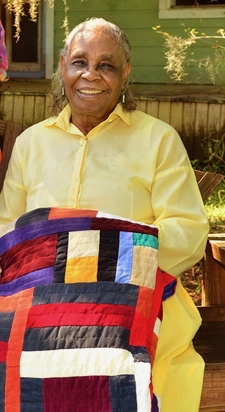Related Research Articles

Folk art covers all forms of visual art made in the context of folk culture. Definitions vary, but generally the objects have practical utility of some kind, rather than being exclusively decorative. The makers of folk art are typically trained within a popular tradition, rather than in the fine art tradition of the culture. There is often overlap, or contested ground with 'naive art'. "Folk art" is not used in regard to traditional societies where ethnographic art continue to be made.
Public folklore is the term for the work done by folklorists in public settings in the United States and Canada outside of universities and colleges, such as arts councils, museums, folklife festivals, radio stations, etc., as opposed to academic folklore, which is done within universities and colleges. The term is short for "public sector folklore" and was first used by members of the American Folklore Society in the early 1970s.

Wendell Castle was an American sculptor and furniture maker and an important figure in late 20th century American craft. He has been referred to as the "father of the art furniture movement" and included in the "Big 4" of modern woodworking with Wharton Esherick, George Nakashima, and Sam Maloof.
The Center for Folklife & Cultural Heritage (CFCH) is one of three cultural centers within the Smithsonian Institution in the United States. Its motto is "culture of, by, and for the people", and it aims to encourage understanding and cultural sustainability through research, education, and community engagement. The CFCH contains (numerically) the largest collection in the Smithsonian, but is not fully open to the public. Its budget comes primarily from grants, trust monies, federal government appropriations, and gifts, with a small percentage coming from the main Smithsonian budget.
The Moulthrop family are three generations of American woodturners, starting with Ed Moulthrop, credited as the "father of modern woodturning". The family has been documented in the book Moulthrop: A Legacy in Wood.

Irván J. "Puco" Pérez was an Isleño folk artist and advocate for the Isleño identity. He is most well known for the singing of décimas, but he was also an accomplished woodcarver. Throughout his life, he assisted academics in the study of the Isleño Spanish language, culture, and customs.

Richard Kurin, an American cultural anthropologist, museum official and author, is the Acting Provost and Under Secretary for Museums and Research at the Smithsonian Institution. He is a key member of the senior team managing the world's largest museum and research complex with 6,500 employees and a $1.4 billion annual budget, caring for more than 139 million specimens, artifacts and artworks, working in 145 countries around the globe, hosting some 30 million visitors a year, and reaching hundreds of millions online and through the Smithsonian's educational programs and media outreach. Kurin is particularly responsible for all of the national museums, scholarly and scientific research centers, and programs spanning science, history, art and culture.
A duck decoy is a man-made object resembling a duck. Duck decoys are typically used in waterfowl hunting to attract real ducks, but they are also used as collectible art pieces. Duck decoys were historically carved from wood, often Atlantic white cedar wood on the east coast of the United States, or cork. Modern ones may also be made of canvas and plastic. They are often painted to resemble various kinds of waterfowl.

Kelly Jean Church is a black ash basket maker, Woodlands style painter, birchbark biter, and educator.
Nellie Mae Rowe was an African-American artist from Fayette County, Georgia. Although she is best known today for her colorful works on paper, Rowe worked across mediums, creating drawings, collages, altered photographs, hand-sewn dolls, home installations and sculptural environments. She was said to have an "instinctive understanding of the relation between color and form." Her work focuses on race, gender, domesticity, African-American folklore, and spiritual traditions.

Jerry Dolyn Brown was an American folk artist and traditional stoneware pottery maker who lived and worked in Hamilton, Alabama. He was a 1992 recipient of a National Heritage Fellowship from the National Endowment for the Arts and a 2003 recipient of the Alabama Folk Heritage Award. His numerous showings included the 1984 Smithsonian Festival of American Folklife with his uncle, potter Gerald Stewart.
Roland L. Freeman was an American photographer and documenter of Southern folk culture and African-American quilters. He was the president of The Group for Cultural Documentation, founded in 1991 and based in Washington, D.C.
Jiha Moon is a contemporary artist who focuses on painting, printmaking, and sculptural ceramic objects. Born in Daegu, South Korea, Moon is currently based in Tallahassee, Florida, after years of living and working in Atlanta, Georgia. She joined Florida State University's Art department faculty in the fall of 2023.
Charles Counts (1934–2000) was an American potter, designer, textile artist, quilter, teacher, writer, and activist. Counts worked to preserve the art forms of his native Appalachia, and later moved to Nigeria where he taught until his death.
Myra Mimlitsch-Gray is an American metalsmith, artist, critic, and educator living and working in Stone Ridge, New York. Mimlitsch-Gray's work has been shown nationally at such venues as the John Michael Kohler Arts Center, Museum of the City of New York, Metropolitan Museum of Art, Cooper-Hewitt Smithsonian Design Museum, and Museum of Arts and Design. Her work has shown internationally at such venues as the Middlesbrough Institute of Modern Art, Stadtisches Museum Gottingen, and the Victoria and Albert Museum, and is held in public and private collections in the U.S, Europe, and Asia.
Homer Fulcher was a duck decoy carver from the Core Banks community of Stacy, North Carolina.

Mary Lee Bendolph is an American quilt maker of the Gee's Bend Collective from Gee's Bend (Boykin), Alabama. Her work has been influential on subsequent quilters and artists and her quilts have been exhibited in museums and galleries around the country. Bendolph uses fabric from used clothing for quilting in appreciation of the "love and spirit" with old cloth. Bendolph has spent her life in Gee's Bend and has had work featured in the Philadelphia Museum of Art as well as the Minneapolis Institute of Art in Minnesota.
Mireille Delismé,, is a Haitian drapo Vodou artist from Léogâne, Haiti.

Cherish Nebeshanze Parrish is a black ash basket maker and birchbark biter. She is a member of the Match-e-be-nash-she-wish Band of Pottawatomi Indians of Michigan and of Odawa descent.
C. Kurt Dewhurst is an American curator and folklorist. Dewhurst is Director for Arts and Cultural Partnerships at Michigan State University (MSU) and also a Senior Fellow in University Outreach and Engagement. At MSU, he is also Director Emeritus of the Michigan State University Museum and a Professor of English and Museum Studies.
References
- ↑ "", Digital Library of Georgia - Ernie Mills: decoy maker. Retrieved 2021-11-12.
- ↑ " Archived 2010-12-13 at the Wayback Machine ", Cultivating Life: Duck Decoy Maker. Retrieved 2021-11-12.
- ↑ Ducks Unlimited, Hail Call publication, August 2012. Retrieved 12 Nov 2021
- ↑ Cashman, Ray; Mould, Tom; Shukla, Pravina (2011-09-21). The Individual and Tradition: Folkloristic Perspectives. Indiana University Press. ISBN 978-0-253-22373-9.
- ↑ Museum), Goizueta Folklife Gallery (Atlanta History; Burrison, John A. (2000). Shaping Traditions: Folk Arts in a Changing South : a Catalog of the Goizueta Folklife Gallery at the Atlanta History Center. University of Georgia Press. ISBN 978-0-8203-2150-9.
- ↑ "Ernie Mills: Decoy Maker". New Georgia Encyclopedia. Retrieved 2024-02-06.
- ↑ Atlanta History - Volumes 37-38, 1993, page 72. Retrieved 12 Nov 2021
- ↑ The Albany Herald. February 23, 1998. p. 8.
{{cite news}}: Missing or empty|title=(help)